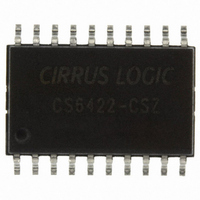CS6422-CSZ Cirrus Logic Inc, CS6422-CSZ Datasheet - Page 38

CS6422-CSZ
Manufacturer Part Number
CS6422-CSZ
Description
IC SPEAKERPHONE ENHANCED 20SOIC
Manufacturer
Cirrus Logic Inc
Type
Audio Processorr
Datasheet
1.CS6422-CSZ.pdf
(48 pages)
Specifications of CS6422-CSZ
Package / Case
20-SOIC
Applications
Speakerphones
Mounting Type
Surface Mount
Product
General Purpose Audio Amplifiers
Available Set Gain
34 dB
Thd Plus Noise
0.03 %
Operating Supply Voltage
5 V
Supply Current
10 mA, 50 mA
Maximum Operating Temperature
+ 70 C
Mounting Style
SMD/SMT
Audio - Load Impedance
10 KOhms
Input Offset Voltage
2.12 V
Minimum Operating Temperature
0 C
Supply Voltage (max)
5.5 V
Supply Voltage (min)
4.5 V
Rohs Compliant
Yes
Operating Temperature Range
0°C To +70°C
Digital Ic Case Style
SOIC
No. Of Pins
20
Lead Free Status / RoHS Status
Lead free / RoHS Compliant
Lead Free Status / RoHS Status
Lead free / RoHS Compliant, Lead free / RoHS Compliant
Other names
598-1200-5
Available stocks
Company
Part Number
Manufacturer
Quantity
Price
Company:
Part Number:
CS6422-CSZ
Manufacturer:
CIRRUS
Quantity:
61
Company:
Part Number:
CS6422-CSZ
Manufacturer:
CIRRUS
Quantity:
4
Part Number:
CS6422-CSZ
Manufacturer:
CIRRUS
Quantity:
20 000
Company:
Part Number:
CS6422-CSZR
Manufacturer:
CREE
Quantity:
210
loop (near-end speaker/mic to far-end speaker/mic)
during a double-talk scenario (where both near-end
and far-end parties are talking at the same time).
The CS6422 implements an optional attenuation
feature that introduces a programmable amount of
loss in the transmit and/or receive directions dur-
ing double-talk to alleviate stability concerns with-
out sacrificing speaker volume. This allows for
higher speaker volume levels at both ends of the
call without compromising stability.
4.1.4.4
Noise Guard is an optional noise squelch feature
that operates in the transmit path (near-end micro-
phone to far-end speaker). In traditional systems, if
the near-end talker is located in a noisy environ-
ment, the near-end system will remain in transmit
mode and transmit that noise to the far-end listener.
While this may be bothersome to the far-end listen-
er using a standard handset, this creates a real prob-
lem if the listener is using a traditional half-duplex
speakerphone because the far-end phone may stay
in receive mode and not allow the far-end talker to
be heard. Noise guard eliminates this problem by
squelching the transmit channel at the near-end un-
less near-end speech is detected, permitting the far-
end speakerphone to switch normally during the
conversation.
4.2
The design of the CS6422 interface circuitry plays
an important role in achieving optimum perfor-
mance. The actual circuit design is important, espe-
cially the analog interface. Proper grounding and
layout will help minimize the noise that might get
coupled into the CS6422.
4.2.1
Of the CS6422 interfaces, the analog interface and
the microcontroller interface are the most impor-
tant to pay special attention to during circuit de-
sign. The analog interface especially will
38
38
Circuit Design
Interface Considerations
Noise Guard
determine how well the echo canceller can per-
form.
4.2.1.1
The Analog Interface feeds information about the
echo path to the adaptive filter, so it is critical that
this interface be well designed. Using high-quality
transducers and circuits that guarantee low-distor-
tion and minimal clipping are essential to the suc-
cess of any echo canceller based design.
As mentioned in Section 4.1.1.2, “Adaptive Filter”,
the adaptive filter assumes that the echo path is lin-
ear and time-invariant. As such, poor quality
speakers are a common cause of poor echo cancel-
ler performance due to their high distortion. Speak-
ers must be selected with their linearity in mind. In
general, the speaker should have less than 2% Total
Harmonic Distortion (THD). This will result in dis-
tortion terms 34 dB below the desired signal,
enough headroom for the echo canceller to function
adequately.
The other major consideration in the design of the
analog interface is that the circuitry that processes
the transducer signals not clip or distort it. For ex-
ample, a common problem is the use of a speaker
amplifier with a fixed gain, which clips when driv-
ing the speaker. Although the distortion may not be
objectionable to the human ear, it will prevent the
adaptive filter from modeling the path correctly.
Speakers and microphones which worked for half-
duplex speakerphones will not necessarily work for
full-duplex speakerphones. Microphone amplifier
circuitry is also suspect when looking for sources
of clipping and distortion.
4.2.1.2
The Microcontroller Interface is the only asynchro-
nous digital connection to the CS6422, so it is the
most likely place for digital noise coupling to be a
problem. The interface itself is fairly straightfor-
ward and requires only three pins from a microcon-
troller.
Analog Interface
Microcontroller Interface
CS6422
CS6422
DS295F1

















